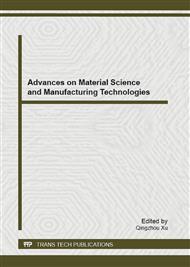[1]
Z. R. Tian, J. A. Voigt, J. Liu, et al., Complex and oriented ZnO nanostructures, Nature Materials., vol. 2, p.821, (2003).
Google Scholar
[2]
S. Kan, T. Mokari, E. Rothernberg, and U. Banin, Selective Growth of Metal Tips onto Semiconductor Quantum Rods and Tetrapods, Nature Materials., vol. 2, p.155, (2003).
DOI: 10.1126/science.1097830
Google Scholar
[3]
Y. N. Xia, P. D. Yang, Y. Sun, et al, Electrical Transport and Chemical Sensing Properties of Individual Conducting Polymer Nanowires, Adv. Mater., vol. 5, p.353, (2003).
Google Scholar
[4]
G. C. Yi, C. R. Wang, and W.I. Park, Preparation and optical properties of one dimensional nano hydroxides and oxides, Semicond. Sci. Technol., vol. 20, S22, (2005).
Google Scholar
[5]
A. B. Djurisˇic´, Y. H. Leung, Optical Properties of ZnO Nanostructures, Appl. Phys. Lett, vol. 84, p.2635, (2004).
Google Scholar
[6]
H. J. Fan, W. Lee, R. Scholz, et al, Arrays of vertically aligned and hexagonally arranged ZnO nanowires: a new template-directed approach, Nanotechnology., vol. 16, p.913, (2005).
DOI: 10.1088/0957-4484/16/6/048
Google Scholar
[7]
M. P. Pilieni, Control of the Morphology and Optical Properties of ZnO Nanostructures via Hot Mixing of Reverse Micelles, Nature., vol. 2, p.145, (2003).
Google Scholar
[8]
J. Zhang, L. D. Sun, H. Y. Pan, et al, Shape Evolution of One-Dimensional Single-Crystalline ZnO Nanostructures in a Microemulsion System, New. J. Chem., vol. 26, p.33, (2002).
Google Scholar
[9]
T. Ahmad, S. Vaidya, N. Sarkar, et al, Zinc oxalate nanorods: a convenient precursor to uniform nanoparticles of ZnO, Nanotechnology., vol. 17, p.1236, (2006).
DOI: 10.1088/0957-4484/17/5/012
Google Scholar
[10]
J. Zhang, L. D. Sun, X. C. Jiang, et al, Shape Evolution of One-Dimensional Single-Crystalline ZnO Nanostructures in a Microemulsion System, Crystal Growth & Design., vol. 4, p.309, (2004).
DOI: 10.1021/cg034142r
Google Scholar
[11]
D. Kaneko, H. Shouji, and T. Kawai, Preparation and characterization of nano-ZnO flakes prepared by reactive ion exchange method, Langmuir., vol. 16, p.4086, (2000).
Google Scholar
[12]
B. X. Lin, Z. X. Fu, and Y. B. Jia, Green luminescent center in undoped zinc oxide films deposited on silicon substrates, Appl. Phys. Lett., vol. 79, p.943, (2001).
DOI: 10.1063/1.1394173
Google Scholar


